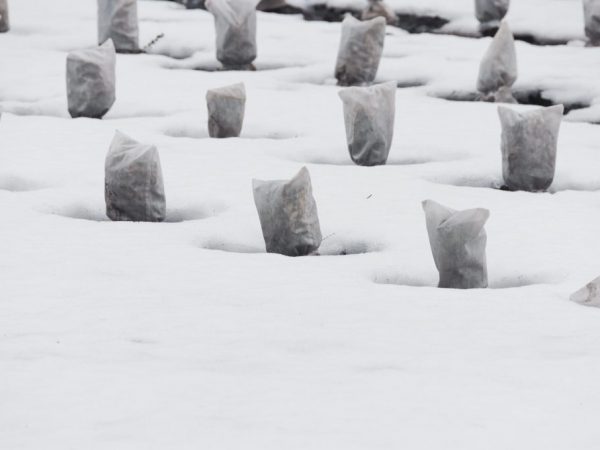Covering materials for grapes
To protect plants from frost, growers widely use a covering material for grapes. This makes it possible to create favorable wintering conditions for the vine.

Covering materials for grapes
What grapes harbor
When choosing a material for sheltering grapes, it is necessary to determine whether it is worth creating additional insulation for the vine or the plant belongs to varietal varieties that cope with winter frosts:
- non-covering varieties that do not require additional insulation include those that are capable of withstanding a temperature drop to -35 ° C-40 ° C, among such - Amur Triumph, Valiant, Sharov's Riddle,
- conditionally covering varieties that require the use of loose protection for the winter and withstand a drop in temperature to -30 ° -33 ° C, among them are Kristall, Platovsky and Marinovsky,
- covering species that die without additional insulation in winter when the temperature drops to -24 ° C-28 ° C, including Elegant, Adel, Salem, Donskoy Agat.
Taking into account these varietal characteristics and the climate of a particular growing region, they decide to use materials for sheltering grapes for the winter.
Film shelters
To insulate the vine before wintering, different types of covering films are used.
Polyethylene
The polyethylene film is designed to protect against light frost and precipitation. One layer of the film cover is able to provide heat when the air drops to -6 ° C. Its strength is average, and the water retention rates are high.
Among the disadvantages of using conventional plastic wrap to cover grapes for the winter is the accumulation of condensation, which leads to the soaking of the vine.
When using simple polyethylene as a shelter, moisture-absorbing and heat-insulating material is additionally laid under it, which are suitable for ordinary straw or dried foliage. The formed structure is not closed from the end edges.
Reinforced polyethylene
Reinforced polyethylene film has increased strength. One layer of it is able to maintain the necessary internal microclimate when the external temperature drops to -8 ° C. Its use follows the same principles as for conventional polyethylene. The disadvantages of reinforced polyethylene are the same.
Air bubble polyethylene
Enhanced thermal insulation qualities are noted in the air bubble polyethylene film, which is able to maintain the thermal balance inside the structure during frosts down to -12 ° C. In the process of application, the use of additional moisture-absorbing layers is required.
Agrofibre Shelters

Agrofibre is widely used for plant shelter
Non-woven agrofibre produced using spunbond technology is widely used as a heater for grapes.Depending on the marking, it has different thicknesses. The recommended covering material for grapes for the winter from agrofibre should have a density of 40 g per sq. m and above.
When using agrofibre for warming a vineyard, take into account that it easily passes moisture.
Before winter, the vines are tied into fascines, wrapped with agrofibre in several layers, and then laid on boards. To prevent moisture penetration during thaw and rains, in order to avoid icing, the shelter is covered with additional protection, which is often used as a plastic wrap.
Shelters made of natural material
As a shelter for grapes for the winter, growers often use natural materials.
Straw
The straw, light in structure, does not cake and retains heat well, however, it requires additional measures against wind and precipitation. In addition, rodents that damage plants start under the straw, and their creation of holes in the straw layer opens up access to frosty air to the vine.
Dried foliage
Well-insulating light dry foliage is an affordable way to keep warm, but it has a significant number of disadvantages:
- often contains fungal spores and bacteria that migrate to the plant and damage the vine, therefore, requires fungicidal treatment before use,
- does not create protection against wind and precipitation without the use of additional means.
Foliage fallen from fruit trees is not used as insulation.
Sawdust
Easily accessible sawdust retains heat well and is suitable for warming grapes.
As a covering layer for vines, only sawdust obtained from coniferous trees, which has antiseptic characteristics, is used. The use of sawdust also requires additional protection measures against precipitation.
Lapnik
Spruce branches create reliable protection against frost. It has antiseptic qualities and prevents rodents from settling and reproducing.
Conclusion
It is possible to create a shelter for grapes for the winter using different methods, each of which has its own advantages and disadvantages. The best option for warming a plant is a combination of several types of covering material.


